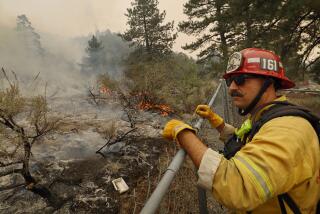‘Midsummer Conditions’ : Low Rainfall Brings Early Fire Season
A dearth of winter rain has left wild vegetation so dry that the brush-fire season is starting earlier than usual, according to fire officials in Los Angeles and Ventura counties.
“It’s here early and we can see it,” said Bill Wright, vegetation officer for the Ventura County Fire Department. Wright and officials in Los Angeles County, who weigh hillside vegetation and packs of 100-gram wooden dowels to determine moisture content, say the brush is drier now than it ordinarily would be in spring.
“It’s equivalent to midsummer conditions right now,” said Capt. Jim Haworth, who is in charge of brush clearance for the Los Angeles City Fire Department. Ordinarily, he said, “Our brush-fire season doesn’t start until August or September but already we’re having brush fires.”
In the past two weeks, firefighters have been called to at least 15 small brush or grass fires in northern Los Angeles County and at least 10 in Ventura County, fire officials said.
Lack of Rainfall, Winds Blamed
The fires were relatively minor, although one destroyed a home in Halsey Canyon and another consumed 50 acres near Castaic. Officials attributed the sporadic outbreak of fires, normally not a problem until late May or June, to dry conditions caused by the lack of rain and Santa Ana winds, Haworth said.
Since July 1, only 7.61 inches of rain has fallen in the Los Angeles area, slightly more than half the 14.42 inches normal for the period, according to the National Weather Service. Rainfall from January through March totaled 3.56 inches, compared to 13.81 inches in the same period last year, the weather service said.
To measure moisture in wild brush, fire officials gather plant samples, weigh them, dry them in an oven for up to 16 hours and weigh them again, Wright said. To get an idea of the moisture content of dead wood in the area, they weigh packs of wooden dowels that are left outside to be dried by the sun and moistened by rain and humidity. The figures are compared with the sticks’ dry weight to indicate the effect the weather is having on dead brush.
Dowel measurements this year reflect the lack of rain, said John Haggenmiller, a Los Angeles County senior deputy forester.
But the moisture measurements of the wild brush have been especially dramatic, Haggenmiller said.
At this time of year, the moisture in most wild brush should equal up to two times the dry weight of the plant, Haggenmiller said. Instead, most plants contain moisture equal to about 70% to 100% of their dry weight, he said.
Brush is considered critically dry at 65%, he said, when “even though the vegetation appears green, it all burns as though it were dead.”
The lowest measure on record was 29% in 1961, an especially severe year for brush fires, Haworth said.
This year’s dry conditions prompted the state Department of Forestry and Fire Protection to authorize its 22 fire ranger stations Tuesday to hire seasonal firefighters several days early, department spokeswoman Lisa Boyd said. The seasonal workers ordinarily are not hired until May 1, she said.
In addition to the lack of rain, fire officials in Los Angeles and Ventura counties are concerned that several winter cold snaps may have killed an abnormally large amount of brush, creating more ready fuel for brush fires, Wright said. There also is a continuing problem with the mysterious “dieback” that has been killing wild brush in Southern California in recent years, he said.
More to Read
Sign up for Essential California
The most important California stories and recommendations in your inbox every morning.
You may occasionally receive promotional content from the Los Angeles Times.










